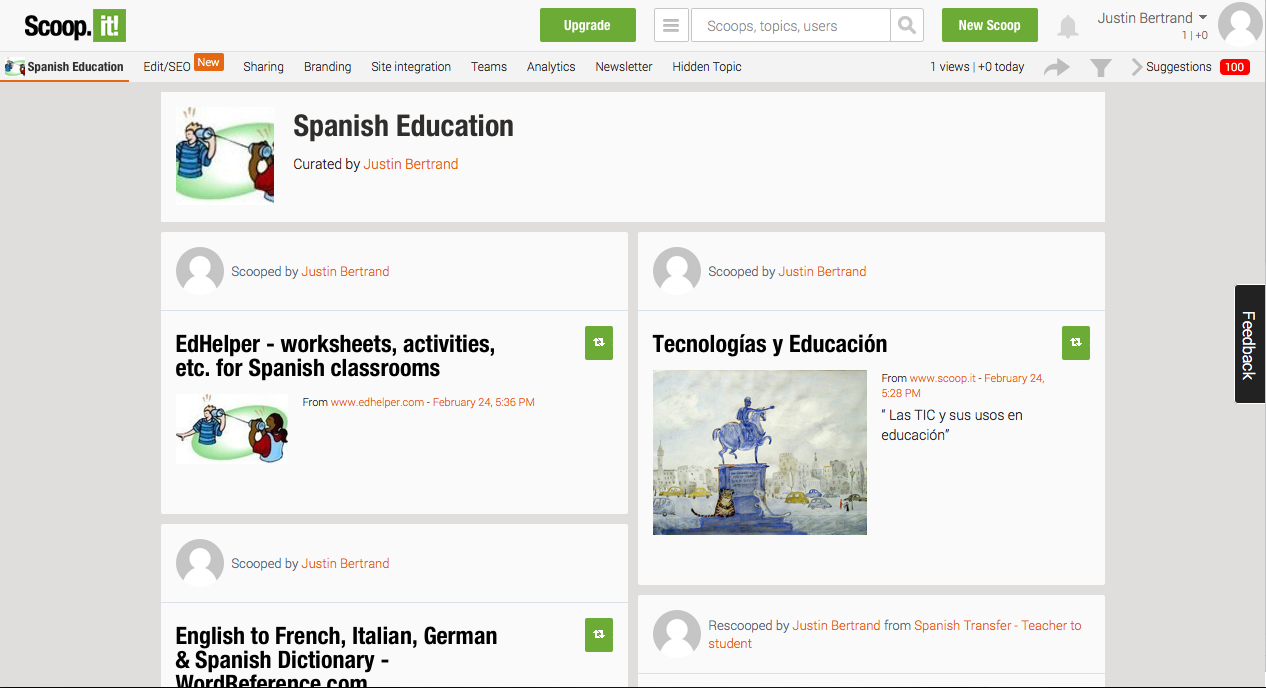A letter to my hordes of followers:
--------------
Dear hordes,
As you know, the purpose of this blog is to explore the ways in which technology, especially various websites and online services, can benefit teachers and students in the pursuit of education. Several weeks ago, this search led me to investigate methods of social bookmarking and curation - that is, ways to keep track of all the other cool stuff I've found. I signed up for two resources, called Diigo (https://www.diigo.com/) and Scoop It (http://www.scoop.it/), which I promptly neglected to share with you, my loyal readers. Please excuse this oversight as I attempt to correct it.
Sincerely,
Justin
--------------
As mentioned in the above address, Diigo and Scoop It are sites that allow you to organize links to other sites and pages. Diigo comes with a downloadable toolbar that you can use to link posts and access your library from anywhere on the web. Diigo allows you to add tags to links as you add them, and search by these tags so that your library can continue to grow without becoming unnavigable. You can also search the entirety of Diigo using the same tag system, allowing you to access useful material collected by other Diigo users. You can group your links in lists, add summaries, and highlight key sections of the target page that will remain highlighted whenever you follow your Diigo link there, so key information won't get lost in a busy page.
Scoop It functions more like Pinterest (https://www.pinterest.com/), a popular casual curation site. Scoop It also offers a toolbar, and links appear on your profile page with images and short selections of text. This feature makes browsing through your own and other users' posted content much quicker and more engaging, a definite step up from Diigo's all-text interface. Scoop It also suggests pages for you based on your activity and the activity of other users with similar interests, which is a great feature for finding new resources.
All in all, I prefer Scoop It. Not only is it more similar to what I'm used to, but the visual aesthetics are a nice touch that makes the site seem friendlier and easier to navigate, while the suggested posts are a wonderful feature for those interested in finding more of what they like - which is likely everyone.
Friday, May 9, 2014
Monday, May 5, 2014
Learning Podcasts
Our exploration of online teaching tools continues this week with a focus on podcasting. For those not in the know, podcasts are like radio shows (though they can also include video) that you can download to your computer or a mobile device. What makes podcast shows different from radio shows is that they can be made by anybody with a microphone and an internet connection, and that you can listen to them anywhere - once you've downloaded the file, you can take it with you and enjoy it any time, any place.
I found a podcast that would be a wonderful supplement in my Spanish classroom called Español Podcast / Spanishpodcast (www.spanishpodcast.org). As the name suggests, it's a podcast series in Spanish. The show is targeted at Spanish L2 learners with an English-speaking background. Episodes begin with a short introduction in English, which is then repeated in Spanish and followed in the same language by the rest of the show. Each episode is centered on a particular topic, and is designed to facilitate learning of the vocabulary and other language features that pertain to that topic. I listened to ¿Hay wifi?, which centers on a conversation a man named Bob has with a hotel receptionist regarding the hotel's wifi services.
The host, Mercedes, speaks clearly with a native Barcelonian accent and at an easy-to-follow pace. Even better for learners, episodes also include a transcript so that listeners can read along while they listen to the words. By including multimodal input (text and audio), Spanishpodcast allows simultaneous visual and aural learning. These two input styles reinforce each other, so that students who may struggle with one or the other on its own instead find spoken language paired with text, encouraging deeper understanding of Spanish as they engage more fully and experience the connectedness of these two aspects of the same language.
I found a podcast that would be a wonderful supplement in my Spanish classroom called Español Podcast / Spanishpodcast (www.spanishpodcast.org). As the name suggests, it's a podcast series in Spanish. The show is targeted at Spanish L2 learners with an English-speaking background. Episodes begin with a short introduction in English, which is then repeated in Spanish and followed in the same language by the rest of the show. Each episode is centered on a particular topic, and is designed to facilitate learning of the vocabulary and other language features that pertain to that topic. I listened to ¿Hay wifi?, which centers on a conversation a man named Bob has with a hotel receptionist regarding the hotel's wifi services.
The host, Mercedes, speaks clearly with a native Barcelonian accent and at an easy-to-follow pace. Even better for learners, episodes also include a transcript so that listeners can read along while they listen to the words. By including multimodal input (text and audio), Spanishpodcast allows simultaneous visual and aural learning. These two input styles reinforce each other, so that students who may struggle with one or the other on its own instead find spoken language paired with text, encouraging deeper understanding of Spanish as they engage more fully and experience the connectedness of these two aspects of the same language.
Subscribe to:
Posts (Atom)

